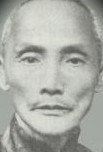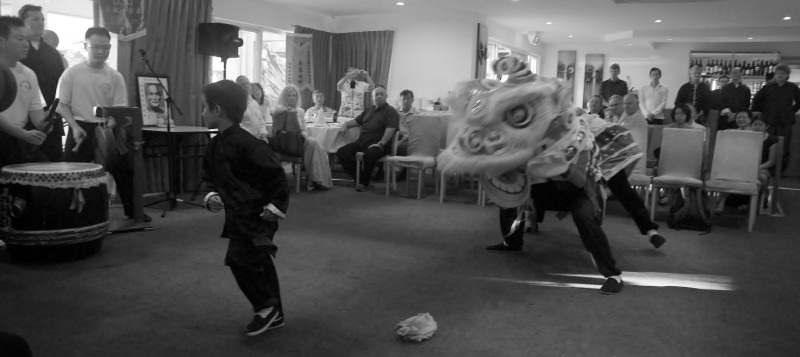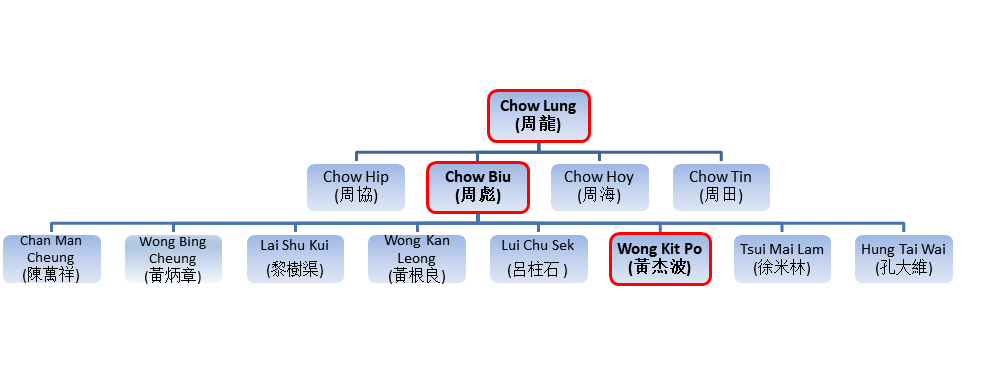Chow Gar Kung Fu – Chow Biu Lineage
Wong’s Academy of Chinese Martial Arts is a traditional southern Chinese kung fu school teaching Chow Gar kung Fu to members from the age of 8 upwards.
The Academy is founded upon the principles of respect, integrity, honour, virtue and goodwill to all. These are values that are expected from all of the Academy’s members. Chow Gar and Tai Chi are both taught in the traditional manner, requiring from student; diligence, patience, self-discipline and application.
Chow Gar is a traditional style of kung fu from Southern China dated back to the early 20th century, and is a style that combined the fundamental elements of two older southern kung fu styles, Hung Gar (洪家) and Choy Gar (蔡家). Hung Gar is typically characterised by strong low stances and its hand techniques, whereas Choy Gar was known for its fast execution of hand and foot work. Chow Gar combines the best elements of both, it is often called Hung’s Head & Choy’s Tail (Hung Tao Choy Mei, 洪頭蔡尾).
 Wong’s Academy of Chinese Martial Arts teaches Chow Gar kung fu in the traditional way passed down from Chow Gar Co-Founder Chow Biu through Professor Wong Kit Po. There is no coloured belt grading and while instruction is gained in groups of students according to their general level of knowledge and aptitude, the Academy understands that progress for each student is an individual path so there is no pressure to move up in “levels”. Wong’s Academy of Chinese Martial Arts teaches Chow Gar in a friendly collegiate and non-aggressive atmosphere where the progress of each student is more important than competition.
Wong’s Academy of Chinese Martial Arts teaches Chow Gar kung fu in the traditional way passed down from Chow Gar Co-Founder Chow Biu through Professor Wong Kit Po. There is no coloured belt grading and while instruction is gained in groups of students according to their general level of knowledge and aptitude, the Academy understands that progress for each student is an individual path so there is no pressure to move up in “levels”. Wong’s Academy of Chinese Martial Arts teaches Chow Gar in a friendly collegiate and non-aggressive atmosphere where the progress of each student is more important than competition.
The Academy teaches formal classes on Saturday afternoons that include a balanced training regime consisting of; warm up and stretching exercises, basic stances and drills, forms, set sparing drills and light/non-contact free sparing with discipline and control. Some empty hand forms that students will learn over time include (pronounced in Cantonese):
– Siew Fok Fu (小伏虎, Small Taming Tiger)
– Sei Peng Kuen (四平拳, Four Direction/Corners Fist)
– Lohon Kuen (羅漢拳, Buddha Fist)
– Siew Ying Jow (小鷹爪, Small Eagle Claw)
– Chak Siew Fok Fu (拆小伏虎, Small Taming Tiger Sparring Form)
– Fah Kuen (花拳, Flower Fist)
– Maan Ji (萬字, Ten Thousand Character Fist)
– Chai Chong (柴樁, Wooden Post Form)
– Gok Chi (國字, Country Character Fist)
– Lok Gok Jong (六國總, Six Countries Fist)
– Fu Pau Kuen (虎豹拳, Tiger Leopard Fist)
Weapons are also an integral part of the study of southern Chinese kung fu, and Chow Gar teaches a variety of traditional Chinese weapons; predominantly:
– Seung Tau Kwan (雙頭棍, Double Headed Staff)
– Chak Kwan (拆棍, Two Person Staff Set)
– Chaap Jai (插仔 (匕首), Double Daggers)
– Seung Garp Tan Kwan (雙夾單棍, Double and Single Ended Staff)
– Tan Do (單刀, Single Broadsword)
– Mui Fa Seung Do (梅花雙刀, Double Broadsword)
– Ying Cheong (纓槍, Spear)
However, as per traditional kung fu schools, students learn several non-weapon forms before progressing to weapons according to a progression syllabus that is designed to maximise the understanding of weapon and non-weapon forms as components of an overall study of the Chow style martial art.
Children in particular are not taught weapons until they are old enough to learn to handle them responsibly.
Lion Dance:
As well as traditional Chow Gar  Kung Fu, Wong’s Academy also teaches and performs the Chow Gar Lion Dance. Chow Gar Lion Dance is famous throughout Southern China.
Kung Fu, Wong’s Academy also teaches and performs the Chow Gar Lion Dance. Chow Gar Lion Dance is famous throughout Southern China.
At the Academy, Lion Dance is not mandatory and is only taught to selected students by invitation.
Chow Gar Lineage

This lineage shows the transmission of Chow Gar in relation to Wong’s Academy of Chinese Martial Arts only. Grandmaster WONG Kit Po acknowledged his many Si-heng and Si-dai who were also disciples of CHOW Biu Si Gung, including (but not limited to): CHAN Man Cheung 陳萬祥, WONG Bing Cheung 黃炳章, LAI Shu Kui 黎樹渠, WONG Kan Leong 黃根良, LUI Chu Sek 呂柱石, TSUI Mai Lam 徐米林 and HUNG Tai Wai 孔大維.
